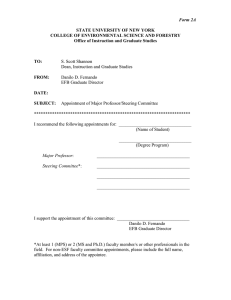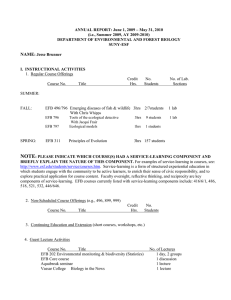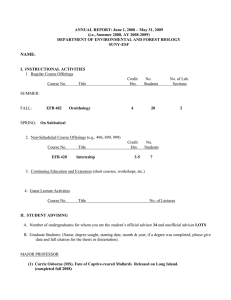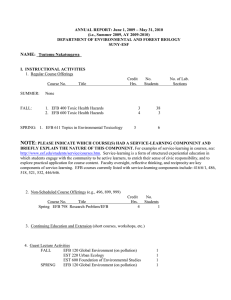ANNUAL REPORT: June 1, 2009 – May 31, 2010
advertisement
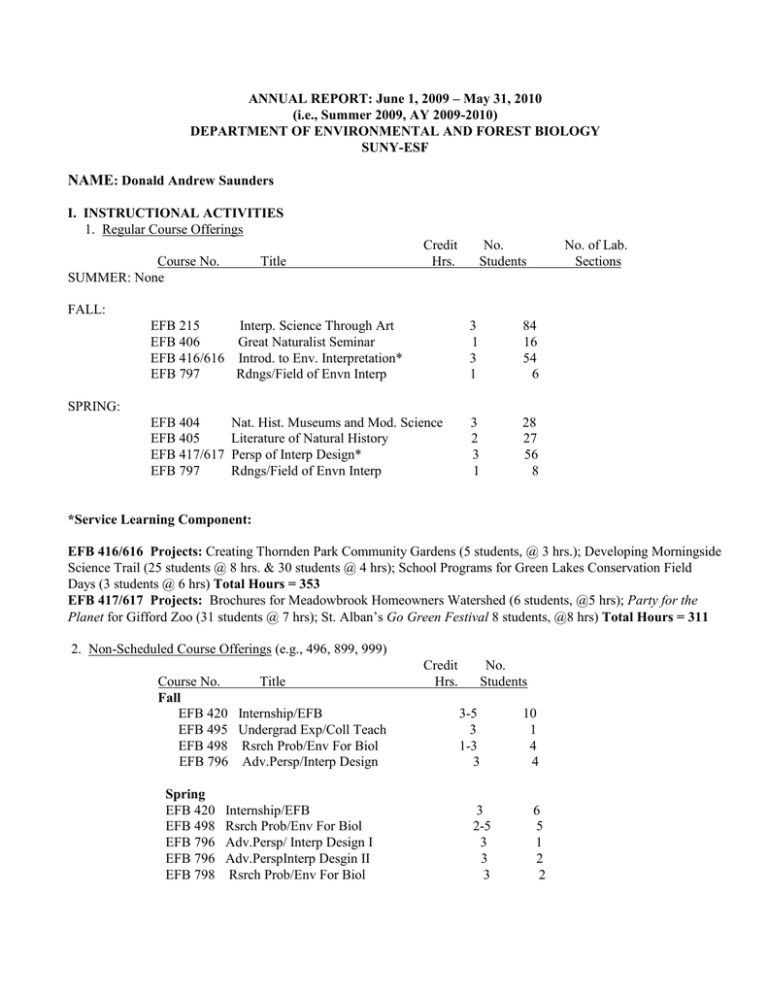
ANNUAL REPORT: June 1, 2009 – May 31, 2010 (i.e., Summer 2009, AY 2009-2010) DEPARTMENT OF ENVIRONMENTAL AND FOREST BIOLOGY SUNY-ESF NAME: Donald Andrew Saunders I. INSTRUCTIONAL ACTIVITIES 1. Regular Course Offerings Course No. SUMMER: None Title Credit Hrs. No. Students No. of Lab. Sections FALL: EFB 215 Interp. Science Through Art EFB 406 Great Naturalist Seminar EFB 416/616 Introd. to Env. Interpretation* EFB 797 Rdngs/Field of Envn Interp 3 1 3 1 84 16 54 6 EFB 404 EFB 405 EFB 417/617 EFB 797 3 2 3 1 28 27 56 8 SPRING: Nat. Hist. Museums and Mod. Science Literature of Natural History Persp of Interp Design* Rdngs/Field of Envn Interp *Service Learning Component: EFB 416/616 Projects: Creating Thornden Park Community Gardens (5 students, @ 3 hrs.); Developing Morningside Science Trail (25 students @ 8 hrs. & 30 students @ 4 hrs); School Programs for Green Lakes Conservation Field Days (3 students @ 6 hrs) Total Hours = 353 EFB 417/617 Projects: Brochures for Meadowbrook Homeowners Watershed (6 students, @5 hrs); Party for the Planet for Gifford Zoo (31 students @ 7 hrs); St. Alban’s Go Green Festival 8 students, @8 hrs) Total Hours = 311 2. Non-Scheduled Course Offerings (e.g., 496, 899, 999) Course No. Title Fall EFB 420 Internship/EFB EFB 495 Undergrad Exp/Coll Teach EFB 498 Rsrch Prob/Env For Biol EFB 796 Adv.Persp/Interp Design Spring EFB 420 EFB 498 EFB 796 EFB 796 EFB 798 Internship/EFB Rsrch Prob/Env For Biol Adv.Persp/ Interp Design I Adv.PerspInterp Desgin II Rsrch Prob/Env For Biol Credit Hrs. No. Students 3-5 3 1-3 3 3 2-5 3 3 3 10 1 4 4 6 5 1 2 2 3. Continuing Education and Extension (short courses, workshops, etc.) Naturally New York : 14 programs, October, 2009 to June, 2010. 15 participants. 4. Guest Lecture Activities Course No. II. STUDENT ADVISING Title No. of Lectures A. Number of undergraduates for whom you are the student’s official advisor: 37 and unofficial advisor 2 B. Graduate Students: (Name, degree sought, starting date, month & year; if a degree was completed, please give date and full citation for the thesis or dissertation). MAJOR PROFESSOR Anne Schlesinger MPS Kendra Ormerod MPS Noah Beck MPS Amanda Joy MPS Becky Begay August, 2008. Completed May, 2010 August, 2009. Completed May, 2010 August, 2009. in progress (dual SU Sci-Ed) August, 2009. in progress (dual SU Sci-Ed) MPS August, 2009. in progress (December, 2011) III. RESEARCH COMPLETED OR UNDERWAY A. Departmental Research (unsupported, boot-legged; title - % time spent) : None B. 1. Grant-supported Research (source, subject, amount - total award and current year, award period starting and ending dates; list graduate research assistants supported by each grant): None 2. Research Proposals pending (include information as in B.1., above): None 3. Research Proposals submitted, but rejected (include information as in B.1, above): None IV. PUBLICATIONS (Full bibliographic citation, i.e., do not use "with Jones," or "Jones, et al."; please list only publications published, in press, or actually submitted during this reporting period --- do not list manuscripts in preparation). A. Refereed Publications B. Non-refereed Publications: Revised final editions: Science Trails Connecting Classrooms to Nature. Robert Kiley, Anne Schlesinger and D. Andrew Saunders; Exploring Morningside Nature Science Trail: Multidisciplinary Activities. Anne Schlesinger and D. Andrew Saunders C. Papers Presented at Science Meetings (give title, date, occasion, and location) None D. Public Service Presentations (lectures, seminars, etc. to and for the public; give group or occasion, date(s), and attendance) Chittenango State Park. August 14, 2009. 25 Habitat Gardening in CNY. March 28, 2010. 35 Go Green Festival . April 24, 2010. 100 V. PUBLIC SERVICE A. Funded Service (include consulting activities) 1. Government Agencies (Federal, State, Local): 2. Industrial and Commercial Groups, etc. B. Unfunded Service to Governmental Agencies, Public Interest Groups, etc. Gifford Zoo Ed Smith Elementary School St. Alban’s Episcopal Church VI. PROFESSIONAL DEVELOPMENT A. Professional Honors and Awards (for teaching, research, outreach, etc.) B. 1. Activities in Professional Organizations (offices held, service as chairman, member, participant or consultant) 2. Professional Society Membership: American Association of Museums 3. Other Professional Activities a. Editorial activity Journal (s) Other (books, symposia, etc.) Responsibility b. Reviewer Journal(s) No. of manuscripts Agency No. of proposals Other c. Participation (workshops, symposia, etc.) Name of workshop, etc. Date Place C. Further Education/Re-training Undertaken, Leaves, Workshops, etc. D. Foreign Travel (Where, When, Purpose) VII. ADMINISTRATIVE AND SERVICE RESPONSIBILITIES (include committee participation) A. Department-level : Open Houses: Fall and Spring, Illick Hall Exhibit preparation and renovation, Coordinating Natural History and Interpretation major, including advising 42 undergraduate and graduate students. B. College-level C. University-wide, including Research Foundation VIII. SUMMARY OF SIGNIFICANT ACTIVITIES AND ACCOMPLISHMENTS DURING THIS REPORTING PERIOD, ESPECIALLY THOSE MOST NOTEWORTHY AND RELATIVE TO THE COLLEGE’S AND DEPARTMENT’S MISSION. One paragraph on each of the following would be most helpful: this past year, what have you done for our students, department/college, and self professionally? NOTE: The information in this section (along with the supporting specific information elsewhere in this report) should be your strongest case for being considered for a discretionary raise, which I’ll continue to award based on your contributions to the department and college this reporting period. Drawing lines among these contributions poses challenges because in nearly all cases, what benefits one audience also benefits the others. Students: I have ended my professional career at ESF this past year by offering quality courses to record enrollments for each course. As always, the courses have emphasized practical skills equipping graduates for competitive employment. The overarching philosophy for all courses has been promoting the applications of Environmental Interpretation to energize and enrich science communication in its broadest sense. As a special emphasis this year, each course has acknowledged the growing chasm between children and nature, the hazards of this gulf, and practical solutions to the problem within the realm of all resource professionals, but especially interpreters/educators. From my perspective, each of my courses was the best of the series that I have offered at ESF over the decades. However, this is a distinction that ultimately rests with the opinions of my students. I am fortunate. This past year was one of the most enjoyable of my 25-year career at ESF, a consequence of several conditions such as wonderful students in each course, and to dedicated TAs helping with the courses. The Ottawa Museums Field Trip for EFB 404, Natural History Museums and Modern Science during “spring break” was the most profitable and enjoyable of any field trip I have offered during my tenure. The 29 students who accompanied me all expressed appreciation for the experience and benefited from interacting with the many museum professionals who freely shared their time and expertise with us. These were the most courteous, congenial, attentive, and punctual group of ESF students I have entertained on any field trip. At the close of this past semester the Natural History and Interpretation major now accommodates the largest group of students since its inception and is but three students short of the optimum (40) target audience projected at its onset. Department: From the perspective of the department and campus, facilitating and staffing the EFB Open Houses by creating a visitor-friendly venue in Room 12, the Roosevelt Discovery Center, while but a small cog in the campus wheel, helped to recruit new generations of scholars. Overseeing the refurbishing or replacement of some lobby and first floor exhibits, another contribution, also communicates to campus visitors the achievements of colleagues and our students, and available departmental and interdisciplinary programs. Like other dimensions of the Natural History and Interpretation major and the graduate Environmental Interpretation program, the products for one campus audience such as these exhibits prove to be the profession-building experiences for another. Campus: Creating opportunities for the Environmental Interpretation students to move out into the community in service-learning endeavors is another example of this synergism. This past year the interpretation students contributed approximately 664 hours in community products and programs. The successful completion of the Morningside Science and Multidisciplinary Trail exemplifies this service- learning component. The completion of the second and last installment of Naturally New York –dedicated to connecting children and communities to the natural history of Central New York, was made possible through the energies and devotion of MPS graduate student, Anne Schlesinger, assisted by another of my MPS students, Kendra Ormerod. Fifteen community-minded, pre-selected adults participated in this year’s 14-part program. This is another example of a campus program with far-reaching impacts. Final Notes: I retire this summer grateful to my colleagues who helped me establish and maintain the Environmental Interpretation program at SUNY-ESF and its undergraduate Natural History and Interpretation major. Few in academe are extended this honor and it is one I appreciate. I am also grateful to the generations of students who have joined me in the classroom, providing satisfying memories to reflect upon. Our journey has been one of mutual discovery and insight. I am indebted to those who played a key role in ensuring and choosing my successor who will take this program to its next level. Environmental Interpretation in all its forms offers to some of our students satisfying and exciting alternatives to the more traditional science careers. To all our students the program offers an enlightened view of effective and enriched science communication. IX. A. FUTURE PLANS, AMBITIONS, AND POTENTIAL CONTRIBUTIONS FOR YOUR OWN PROFESSIONAL DEVELOPMENT AND THE ENHANCEMENT OF THE PROGRAM IN ENVIRONMENTAL AND FOREST BIOLOGY (brief summary) B. PROJECTED ACTIVITIES FOR NEXT YEAR 1. Summer 2009 a. Course(s) to be offered b. Proposed research activity c. University, professional society, and public service 2. Fall Semester 2009 a. Course(s) to be offered b. Proposed research activity c. University, Professional society, and public service 3. Spring Semester 2010 a. Course(s) to be offered b. Proposed research activity c. University, professional society, and public service
